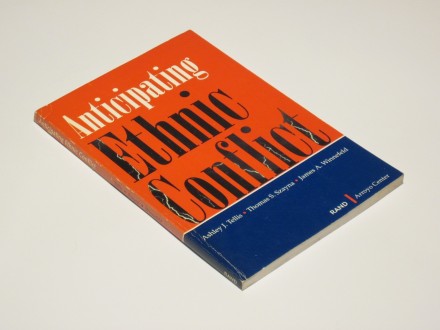Anticipating Ethnic Conflict
| Cena: |
| Želi ovaj predmet: | 1 |
| Stanje: | Polovan bez oštećenja |
| Garancija: | Ne |
| Isporuka: | Pošta Post Express Lično preuzimanje |
| Plaćanje: | Tekući račun (pre slanja) Lično |
| Grad: |
Beograd-Zvezdara, Beograd-Zvezdara |
ISBN: 0833024957
Godina izdanja: 1997
Jezik: Engleski
Autor: Strani
Ashley J. Tellis, Thomas S. Szayna, James A. Winnefeld - Anticipating Ethnic Conflict
RAND Corporation, 1997
118 str.
meki povez
stanje: vrlo dobro, pečat na predlistu.
Review
Presented with admirable crispness.... A concise volume worth reading, and a model worth testing.
Journal of Peace Research
From the Publisher
This report provides a handbook for intelligence analysts to use in thinking about and attempting to anticipate the occurrence of ethnic conflict. The intended audience and users of the handbook are Army intelligence analysts, though analysts from other intelligence agencies also should find it useful. The handbook is formatted as a series of questions and guidelines for the analyst to focus on while preparing an assessment. The questions are based on a conceptual model of ethnic and communitarian strife that focuses on the processes of grievance formation and group mobilization.This document is the final product of a project entitled `Ethnic Conflict and the Processes of State Breakdown: Improving Army Planning and Preparation.` The project aimed to improve the Army`s ability to anticipate ethnic conflict as one aspect of its overall strategic planning and threat assessment. The academic audience will be especially interested in the appendix, whereas the more practically oriented audience may find the handbook of greater interest. The two are provided here because the publication attempts to combine them in order to provide a theoretically grounded tool for practical use.The research was sponsored by the Deputy Chief of Staff for Intelligence, U.S. Army, and was conducted in the Strategy and Doctrine Program of RAND`s Arroyo Center. The Arroyo Center is a federally funded research and development center sponsored by the United States Army.
From the Back Cover
Under what conditions are ethnic groups likely to take up violence against the state? When are they more likely to favor the peaceful pursuit of group aims? When are states likely to resort to violence and repression rather than negotiation? A better understanding and anticipation of such conflicts may improve the prospects for preventive action without force. Anticipating Ethnic Conflict provides a theoretical model of the social processes and dynamics that lead to ethnic and communitarian conflict and state breakdown. While it is designed as a handbook and a practical tool for intelligence analysts as they work to identify and plan for potential ethnic-conflict contingencies around the world, its discussion of the social-science underpinnings of the analytic model will make it an important read for anyone interested in analyzing the phenomenon of ethnic conflict.
About the Author
THOMAS S. SZAYNA (Ph.D., Political Science, University of California, Los Angeles) is the associate director of the Strategy, Doctrine, and Resources Program, Arroyo Center, at RAND. His research includes strategic planning, NATO military force structure and planning, intra-state conflict, peace operations, and democratization and civil-military relations.
Preface Figures Tables Summary Acknowledgments Chapter One - INTRODUCTION Assumptions and Considerations Report Organization Chapter Two- THE MODEL: A SUMMARY Stage 1: The Potential for Strife Stage 2: Transforming Potential Strife into Likely Strife Stage 3: From Likely to Actual Strife Chapter Three - QUESTIONS AND GUIDELINES FOR THE ANALYST A. The Potential for Strife B. Transforming Potential into Likely Strife C. Assessing the State D. Strategic Bargaining Final Observations on Using the Handbook Appendix: THE THEORETICAL MODEL
Contents:
Ch. 1. Introduction
Ch. 2. The Model: A Summary. Stage 1. The Potential for Strife. Stage 2. Transforming Potential Strife into Likely Strife. Stage 3. From Likely to Actual Strife
Ch. 3. Questions and Guidelines for the Analyst. A. The Potential for Strife. A1. Assessing Closure in the Political Realm. A2. Assessing Closure in the Economic Realm. A3. Assessing Closure in the Social Realm. A4. Overall Assessment of Closure. B. Transforming Potential into Likely Strife. B1. Incipient Changes. B2. Galvanizing (`Tipping`) Events. B3. Leadership. B4. Resources and Organization. B5. Foreign Element. B6. Overall Assessment of Mobilization. C. Assessing the State. C1. Accommodative Capability. C2. Fiscal and Economic Capability. C3. Coercive Capability. D. Strategic Bargaining. D1. Measuring the Capacities of the Group and the State. D2. Comparing Preferences Within the Bargaining Process. Final Observations on Using the Handbook
Appendix. The Theoretical Model
Nonfiction, Politics
Plaćanje pouzećem i postnetom za sada nisu opcija.
Lično preuzimanje je isključivo na Konjarniku uz prethodni dogovor.
Hvala na razumevanju.
Predmet: 71956345







